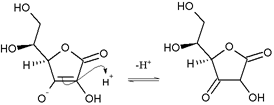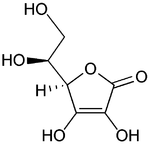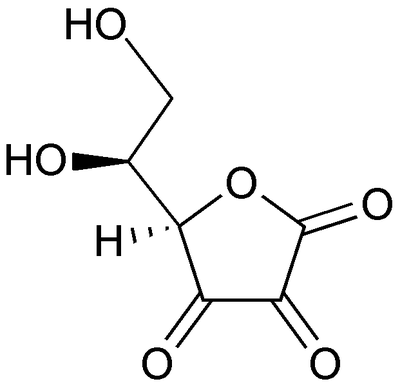Ascorbic acid
Template:Inuse This article will describe the biochemistry of Ascorbic Acid. For the function and effect of Ascorbic Acid on animal species, and its use by humans and the higher primates, please see Vitamin C.
- This article deals with the molecular aspects of ascorbic acid. For information about its purpose in nutrition, see Vitamin C.
Ascorbic acid is an organic acid with antioxidant properties. Its appearance is white to light yellow crystals or powder. It is water soluble. The L-enantiomer of ascorbic acid is commonly known as vitamin C. The name is derived from the alpha privative a- (meaning no) and scorbuticus (scurvy), the disease caused by a deficiency of vitamin C. In 1937 the Nobel Prize for chemistry was awarded to Walter Haworth for his work in determining the structure of ascorbic acid (shared with Paul Karrer, who received his award for work on vitamins), and the prize for Physiology or Medicine that year went to Albert Szent-Györgyi for his studies of the biological functions of L-ascorbic acid. At the time of its discovery in the 1920s it was called hexuronic acid by some researchers.[1]
Chemistry
Acidity
Ascorbic acid behaves as a vinylogous carboxylic acid, where the double bond ("vinyl") transmits electron pairs between the hydroxyl and the carbonyl. There are two resonance structures for the deprotonated form, differing in the position of the double bond.
Another way to look at ascorbic acid is to consider it as an enol. The deprotonated form is an enolate, which are usually strongly basic. However, the adjacent double bond stabilizes the deprotonated form.
Tautomerism

Ascorbic acid also rapidly interconverts into two unstable diketone tautomers by proton transfer, although it is the most stable in the enol form. The proton of the enol is lost, and reacquired by electrons from the double bond, to produce a diketone. This is an enol reaction. There are two possible forms, 1,2-diketone and 1,3-diketone.
Determination
The concentration of a solution of ascorbic acid can be determined in many ways, the most common ways involving titration with an oxidizing agent.
- DCPIP
A commonly used oxidising agent is the dye 2,6-dichlorophenol-indophenol, or DCPIP for short. The blue dye is run into the ascorbic acid solution until a faint pink colour persists for 15 seconds.
- Iodine
Another method involves using iodine and a starch indicator where iodine reacts with ascorbic acid and when all the ascorbic acid has reacted the iodine is then in excess, forming a blue-black complex with the starch indicator. This indicates the end point of the titration. Alternatively, ascorbic acid can be reacted with iodine in excess, followed by back titration with sodium thiosulfate while using starch as an indicator.
- Iodate and iodine
The above method involving iodine requires making up and standardising the iodine solution. One way round this is to generate the iodine in the presence of the ascorbic acid by the reaction of iodate and iodide ion in acid solution.
- N-Bromosuccinimide
A much less common oxidising agent is N-bromosuccinimide, (NBS). In this titration the NBS oxidises the ascorbic acid (in the presence of potassium iodide and starch). When the NBS is in excess (i.e. the reaction is complete) the NBS liberates the iodine from the potassium iodide which then forms the blue/black complex with starch, indicating the end point of the titration.
Uses

|

|
(reduced form of Vitamin C)
Bottom: dehydroascorbic acid
(oxidized form of Vitamin C)
Ascorbic acid is easily oxidized and so is used as a reductant in photographic developer solutions (among others) and as a preservative.
Exposure to oxygen, metals, light and heat destroy ascorbic acid, so it must be stored in dark and cold and not in a metal container.
The oxidized form of ascorbic acid is known as dehydroascorbic acid.
The L-enantiomer of ascorbic acid is also known as vitamin C. The name "ascorbic" comes from its property of preventing and curing scurvy. Primates, including humans, and a few other species in all divisions of the animal kingdom, notably the guinea pig, have lost the ability to synthesize ascorbic acid and must obtain it in their food.
Ascorbic acid and its sodium, potassium, and calcium salts are commonly used as antioxidant food additives. These compounds are water soluble and thus cannot protect fats from oxidation: For this purpose, the fat-soluble esters of ascorbic acid with long-chain fatty acids (ascorbyl palmitate or ascorbyl stearate) can be used as food antioxidants. Eighty percent of the world's supply of ascorbic acid is produced in China. [2]
The relevant European food additive E numbers are:
- E300 ascorbic acid,
- E301 sodium ascorbate,
- E302 calcium ascorbate,
- E303 potassium ascorbate,
- E304 fatty acid esters of ascorbic acid (i) ascorbyl palmitate (ii) ascorbyl stearate.
It can be added to water that has been treated with iodine to make it potable, neutralizing the unpleasant iodine taste.
In plastic manufacturing ascorbic acid can be used to assemble molecular chains more quickly and with less waste than traditional synthesis methods.[3]
Antioxidant mechanism
Ascorbate acts as an antioxidant by being itself available for energetically favourable oxidation. Many oxidants (typically, reactive oxygen species) such as the hydroxyl radical (formed from hydrogen peroxide), contain an unpaired electron and thus are highly reactive and damaging to humans and plants at the molecular level. This is due to their interaction with nucleic acid, proteins and lipids. Reactive oxygen species oxidize (take electrons from) ascorbate first to monodehydroascorbate and then dehydroascorbate. The reactive oxygen species are reduced to water while the oxidized forms of ascorbate are relatively stable and unreactive, and do not cause cellular damage.
Ascorbic acid synthesis in non-primates
Ascorbic acid is found in plants, animals, and single cell organisms.[4] All living animals either make it, eat it, or die from scurvy due to lack of it. Reptiles and older orders of birds make ascorbic acid in their kidneys. Recent orders of birds and most mammals make ascorbic acid in their livers where the enzyme L-gulonolactone oxidase is required to convert glucose to ascorbic acid.[5] Humans, guinea pigs, and some other primates are not able to make L-gulonolactone oxidase because of a genetic defect and are therefore unable to make ascorbic acid in their livers. This genetic mutation occurred about 63 million years ago [6] This would have had lethal consequences for the mutated primate were it not for the fact that it occurred to an arboreal animal living in a tropical environment where plenty of foodstuffs containing ascorbic acid were available throughout the year. Although ascorbic acid is a vital food nutrient for humans and is therefore termed a vitamin, it is a natural liver metabolite in most other animals. -->
See also
- Vitamin C: a discussion of the medical properties of ascorbic acid as well as its historic and social role
- Erythorbic acid: a diastereomer of ascorbic acid.
- Mineral ascorbates: salts of ascorbic acid
- D-erythroascorbic acid: yeasts do not make vitamin C (L-ascorbic acid), but a similar antioxidant known as D-erythroascorbic acid
References
- Clayden, Greeves, Warren, Wothers. Organic Chemistry. Oxford University Press (2001), ISBN 0-19-850346-6.
- Derek Denby (May 1996). "Vitamin C". Chemistry Review 5 (5).
- Vitamin C: Its Chemistry and Biochemistry Michael B. Davies, John Austin, David A. Partridge. Royal Society of Chemistry. ISBN 0-85186-333-7
- Food: The Chemistry of Its Components; Third Edition T.P. Coultate. Royal Society of Chemistry. ISBN 0-85404-513-9
- ↑ Joseph Louis Svirbelf, Albert Szent-Gyorgyi The Chemical Nature Of Vitamin C, April 25th, 1932. Part of the National Library of Medicine collection. Accessed January 2007
- ↑ Washington Post, Tainted Chinese Imports Common, published May 20, 2007
- ↑ Newswise. Vitamin C, water have benefits for plastic manufacturing, Reliable Plant Magazine, 2007. Retrieved on 2007-06-25.
- ↑ The Natural History of Ascorbic Acid in the Evolution of Mammals and Primates, Irwin Stone, 1972
- ↑ Stone
- ↑ Stone